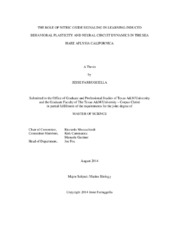| dc.description.abstract | Animals constantly regulate their behaviors in response to environmental stimuli.
These adjustments involve an active and dynamic balance between defensive and non-defensive behaviors, and underlying each change are the fundamental alterations within the neural circuits that form the cellular bases for those behaviors. The marine mollusk Aplysia californica provides an ideal model system for examining plasticity at both the behavioral and neural levels following exposure to aversive stimuli. After receiving a noxious stimulus, Aplysia elicit the learned behavioral change known as
sensitization through which their defensive responses are enhanced, in particular the tail-siphon withdrawal reflex (TSWR). Sensitization of the TSWR manifests from an increase in facilitation at the neuronal synapses that govern the reflex. Sensitization
training induces a concurrent suppression of non-defensive behaviors, particularly feeding behavior. The suppression of feeding results from a decrease in excitability of neuron B51, which is a key decision-making neuron in the feeding neural circuit that is critical to the production of feeding behavior. The neurotransmitter serotonin has been
shown to mediate and induce the sensitization of the TSWR, but it is not involved in the concomitant suppression of feeding behavior. This study proposed the neurotransmitter nitric oxide (NO) as the signaling molecule that mediates the modification of feeding. The goal of this study was to examine the roles of NO signaling in the enhancement of
the TSWR produced by sensitization training, the sensitization training-induced suppression of feeding, and the modulation of the feeding neural circuit. NO signaling was found to be necessary for sensitization training-induced behavioral plasticity. When
NO signaling was pharmacologically blocked by in vivo application of the NO synthase inhibitor Nω-nitro-L-arginine methyl ester (L-NAME), sensitization training failed to produce the sensitization of the TSWR. L-NAME also prevented sensitization training from inducing the suppression of feeding behavior known to occur concomitantly with the sensitization of the TSWR. These results suggested that modifications of both defensive and non-defensive behaviors via aversive learning were prevented when NO signaling was blocked. NO signaling was also found to modulate the Aplysia feeding neural circuit. NO is known to tonically inhibit feeding behavior in vivo. The application of L-NAME in vitro to isolated preparations of the feeding circuit caused the excitability and activity of neuron B51 to increase. Conversely, when NO signaling was augmented by in vitro application of the NO donor S-nitroso-N-acetyl-penicillamine (SNAP) to the
isolated feeding circuit, the excitability of B51 decreased in a manner analogous to that produced by sensitization training. Neither L-NAME nor SNAP treatments affected the
resting membrane properties of B51, indicating that the bidirectional modulation of B51 excitability by NO signaling acts through voltage-dependent channels. Based on these results, it is evident that NO signaling modulates the changes in multiple behaviors following exposure to aversive stimuli, and that NO signaling is significantly involved in and essential for behavioral and cellular plasticity in Aplysia. | en |


